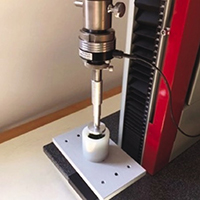Simple and efficient approach for shelf-life test on frozen spinach and parsley

Published: 30 September 2021
Abstract Views: 1040
PDF: 527
HTML: 1019
HTML: 1019
Publisher's note
All claims expressed in this article are solely those of the authors and do not necessarily represent those of their affiliated organizations, or those of the publisher, the editors and the reviewers. Any product that may be evaluated in this article or claim that may be made by its manufacturer is not guaranteed or endorsed by the publisher.
All claims expressed in this article are solely those of the authors and do not necessarily represent those of their affiliated organizations, or those of the publisher, the editors and the reviewers. Any product that may be evaluated in this article or claim that may be made by its manufacturer is not guaranteed or endorsed by the publisher.
Similar Articles
- Simone Pascuzzi, Ileana Blanco, Alexandros Sotirios Anifantis, Giacomo Scarascia-Mugnozza, Hazards assessment and technical actions due to the production of pressured hydrogen within a pilot photovoltaic-electrolyser-fuel cell power system for agricultural equipment , Journal of Agricultural Engineering: Vol. 47 No. 2 (2016)
- Adeshina Fadeyibi, Kehinde Raheef Adebayo, Taiye Mayowa Obafemi, Abiodun Samson Olubo, Rasheed Amao Busari, Mohammed Gana Yisa , Development and evaluation of biomass-based alternative charcoal , Journal of Agricultural Engineering: Vol. 51 No. 3 (2020)
- Giuseppe Toscano, Eleonora Maldini, ANALYSIS OF THE PHYSICALAND CHEMICAL CHARACTERISTICS OF VEGETABLE OILS AS FUEL , Journal of Agricultural Engineering: Vol. 38 No. 3 (2007)
- Filippo Gambella, Harvest of table olives by mechanical harvesting equipment , Journal of Agricultural Engineering: Vol. 44 No. s2 (2013): Proceedings of the 10th Conference of the Italian Society of Agricultural Engineering
- Fabio Pezzi, Giorgio Ade, Francesco Bordini, Alessandro Giunchi, EVALUATION OF THE CUTTING FORCE ON VINE BRANCHES IN WINTER PRUNING , Journal of Agricultural Engineering: Vol. 40 No. 1 (2009)
- Nicoletta Tomasello, Francesa Valenti, Giovanni Cascone, Simona M.C. Porto, Improving natural ventilation in renovated free-stall barns for dairy cows: Optimized building solutions by using a validated computational fluid dynamics model , Journal of Agricultural Engineering: Vol. 52 No. 1 (2021)
- Chiara Cevoli, Angelo Fabbri, Frédérique Pasquali, Annachiara Berardinelli, Adriano Guarnieri, HOT AIR TREATMENT, IN NATURAL CONVECTION CONDITIONS, FOR EGG SURFACE DECONTAMINATION , Journal of Agricultural Engineering: Vol. 41 No. 4 (2010)
- A. Vinci, L. Vergni, F. Todisco, F. Mannocchi, Analysis of rainfed alfalfa evapotranspiration measured by an eddy covariance system , Journal of Agricultural Engineering: Vol. 44 No. s2 (2013): Proceedings of the 10th Conference of the Italian Society of Agricultural Engineering
- R. Oberti, A. Tenca, F. Perazzolo, E. Riva, A. Finzi, E. Naldi, G. Provolo, L. Bodria, A farm-scale pilot plant for biohydrogen and biomethane production by two-stage fermentation , Journal of Agricultural Engineering: Vol. 44 No. s2 (2013): Proceedings of the 10th Conference of the Italian Society of Agricultural Engineering
- A. Comegna, A. Coppola, G. Dragonetti, N. Chaali, A. Sommella, Time domain reflectometry-measuring dielectric permittivity to detect soil non-acqeous phase liquids contamination-decontamination processes , Journal of Agricultural Engineering: Vol. 44 No. s2 (2013): Proceedings of the 10th Conference of the Italian Society of Agricultural Engineering
<< < 32 33 34 35 36 37 38 39 40 41 > >>
You may also start an advanced similarity search for this article.

 https://doi.org/10.4081/jae.2021.1199
https://doi.org/10.4081/jae.2021.1199







